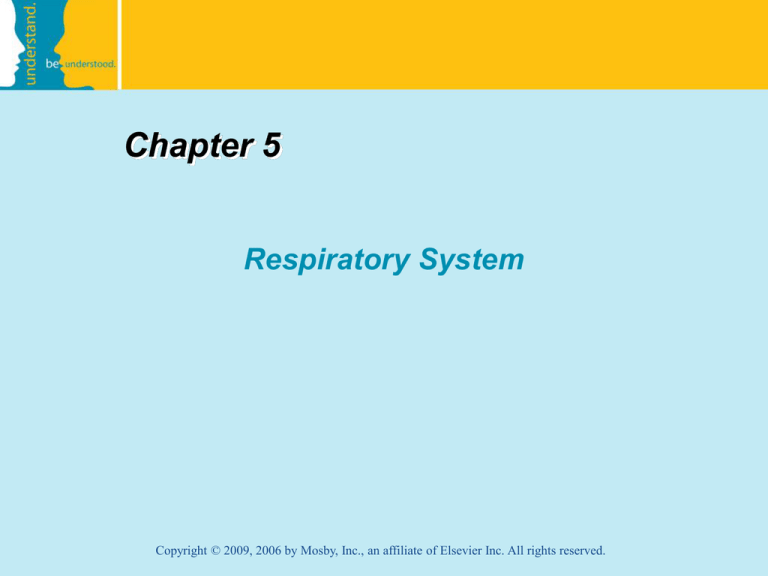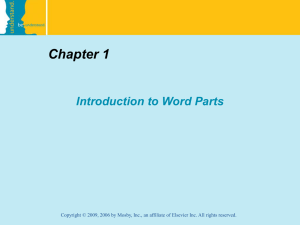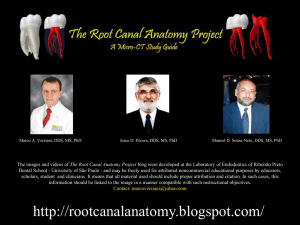
Chapter 5
Respiratory System
Copyright © 2009, 2006 by Mosby, Inc., an affiliate of Elsevier Inc. All rights reserved.
Chapter 5
Lesson 5.1
Copyright © 2009, 2006 by Mosby, Inc., an affiliate of Elsevier Inc. All rights reserved.
5-2
Objectives
Identify organs and structures of the
respiratory system.
Define and spell the word parts related to the
respiratory system.
Define, pronounce and spell disease and
disorder terms related to the respiratory
system.
Define, pronounce and spell surgical terms
related to the respiratory system.
Copyright © 2009, 2006 by Mosby, Inc., an affiliate of Elsevier Inc. All rights reserved.
5-3
Respiratory System Function
Exchange of oxygen and carbon dioxide
between the atmosphere and body cells.
The process is called respiration.
External respiration (breathing): Oxygen passes
from lungs to blood (capillaries) and carbon
dioxide passes from capillaries back into lungs to
be expelled.
Internal respiration: The body cells take on oxygen
from the blood and give back carbon dioxide,
which is transported back to the lungs.
Copyright © 2009, 2006 by Mosby, Inc., an affiliate of Elsevier Inc. All rights reserved.
5-4
Organs of the Respiratory System
Copyright © 2009, 2006 by Mosby, Inc., an affiliate of Elsevier Inc. All rights reserved.
5-5
Organs of the Respiratory System
nose: lined with mucous membrane and fine
hairs; acts as a filter to moisten and warm the
entering air
pharynx (throat): serves as a food and air
passageway
adenoid: lymphoid tissue located behind the
nasal cavity
tonsils: lymphoid tissue located behind the mouth
Copyright © 2009, 2006 by Mosby, Inc., an affiliate of Elsevier Inc. All rights reserved.
5-6
Organs of the
Respiratory System (cont’d.)
larynx (voice box): location of the vocal
cords
epiglottis: flap of cartilage that automatically
covers the opening of the larynx during
swallowing and keeps food from entering the
larynx
trachea: passageway for air to the bronchi
Copyright © 2009, 2006 by Mosby, Inc., an affiliate of Elsevier Inc. All rights reserved.
5-7
Organs of the
Respiratory System (cont’d.)
bronchus: one of two branches from the
trachea, which conducts air into the lungs,
where it divides and subdivides (referred to
as a bronchial tree).
bronchioles: smallest subdivision of the bronchial
tree
alveoli: air sacs at the end of the bronchioles;
oxygen and carbon dioxide are exchanged
through alveolar walls and capillaries
Copyright © 2009, 2006 by Mosby, Inc., an affiliate of Elsevier Inc. All rights reserved.
5-8
Organs of the
Respiratory System (cont’d.)
lungs: 2 sponge-like organs in the thoracic
cavity (right lung has 3 lobes; left lung has 2
lobes)
pleura: serous membrane covering each lung and
lining the thoracic cavity
diaphragm: muscular partition that separates
the thoracic cavity from the abdominal cavity;
aids in breathing
mediastinum: space between the lungs
Copyright © 2009, 2006 by Mosby, Inc., an affiliate of Elsevier Inc. All rights reserved.
5-9
Combining Forms for the
Respiratory System
adenoid/o
alveol/o
bronchi/o, bronch/o
diaphragmat/o
epiglott/o
laryng/o
lob/o
nas/o, rhin/o
pharyng/o
pleur/o
pneum/o, pneumat/o, pneumon/o
pulmon/o
Copyright © 2009, 2006 by Mosby, Inc., an affiliate of Elsevier Inc. All rights reserved.
5-10
Combining Forms for the
Respiratory System (cont’d.)
sept/o
sinus/o
thorac/o
tonsill/o
trache/o
Copyright © 2009, 2006 by Mosby, Inc., an affiliate of Elsevier Inc. All rights reserved.
5-11
Combining Forms Commonly Used
with Respiratory System Terms
atel/o
capn/o
hem/o, hemat/o
muc/o
orth/o
ox/o, ox/i
py/o
spir/o
Copyright © 2009, 2006 by Mosby, Inc., an affiliate of Elsevier Inc. All rights reserved.
5-12
Prefixes
a-, anendoeupanpolytachy-
Copyright © 2009, 2006 by Mosby, Inc., an affiliate of Elsevier Inc. All rights reserved.
5-13
Suffixes
-algia
-ar, -ary
-cele
-centesis
-eal
-ectasis
-emia
-graphy
-meter
-metry
-pexy
Copyright © 2009, 2006 by Mosby, Inc., an affiliate of Elsevier Inc. All rights reserved.
5-14
Suffixes (cont’d.)
-rrhagia
-scope
-scopic
-scopy
-spasm
-stenosis
-stomy
-thorax
-tomy
Copyright © 2009, 2006 by Mosby, Inc., an affiliate of Elsevier Inc. All rights reserved.
5-15
Clicker Question
Which of the following is the combining form
that means chest?
-thorax
b) -pexy
c) thorac/o
d) pleur/o
a)
Copyright © 2009, 2006 by Mosby, Inc., an affiliate of Elsevier Inc. All rights reserved.
5-16
Disease and Disorder Terms
Built from Word Parts
adenoiditis
atelectasis
bronchiectasis
bronchitis
bronchogenic carcinoma
bronchopneumonia
diaphragmatocele
epiglottitis
hemothorax
laryngitis
laryngotracheobronchitis (LTB)
lobar pneumonia
nasopharyngitis
pansinusitis
pharyngitis
pleuritis
Copyright © 2009, 2006 by Mosby, Inc., an affiliate of Elsevier Inc. All rights reserved.
5-17
Disease and Disorder Terms
Built from Word Parts (cont’d.)
pneumatocele
pneumoconiosis
pneumonia
pneumonitis
pneumothorax
pulmonary neoplasm
pyothorax
rhinitis
rhinomycosis
rhinorrhagia
thoracalgia
tonsillitis
tracheitis
tracheostenosis
Copyright © 2009, 2006 by Mosby, Inc., an affiliate of Elsevier Inc. All rights reserved.
5-18
Atelectasis Showing
Collapsed Alveoli
Copyright © 2009, 2006 by Mosby, Inc., an affiliate of Elsevier Inc. All rights reserved.
5-19
Disease and Disorder Terms Not
Built from Word Parts
adult respiratory distress syndrome (ARDS)
asthma
chronic obstructive pulmonary disease (COPD)
coccidioidomycosis
cor pulmonale
croup
cystic fibrosis (CF)
deviated septum
emphysema
epistaxis
influenza (flu)
Copyright © 2009, 2006 by Mosby, Inc., an affiliate of Elsevier Inc. All rights reserved.
5-20
Disease and Disorder Terms Not
Built from Word Parts (cont’d)
Legionnaire disease
obstructive sleep apnea (OSA)
pertussis
pleural effusion
pulmonary edema
pulmonary embolism (PE)
tuberculosis (TB)
upper respiratory infection (URI)
Copyright © 2009, 2006 by Mosby, Inc., an affiliate of Elsevier Inc. All rights reserved.
5-21
Clicker Question
Which of the following correctly labels the
diagram?
a) pneumothorax
b) pleurothorax
Copyright © 2009, 2006 by Mosby, Inc., an affiliate of Elsevier Inc. All rights reserved.
5-22
Surgical Terms Built
from Word Parts
adenoidectomy
adenotome
bronchoplasty
laryngectomy
laryngoplasty
laryngostomy
laryngotracheotomy
lobectomy
pleuropexy
pneumobronchotomy
pneumonectomy
Copyright © 2009, 2006 by Mosby, Inc., an affiliate of Elsevier Inc. All rights reserved.
5-23
Surgical Terms Built
from Word Parts (cont’d)
rhinoplasty
septoplasty
septotomy
sinusotomy
thoracocentesis
thoracotomy
tonsillectomy
tracheoplasty
tracheostomy
tracheotomy
Copyright © 2009, 2006 by Mosby, Inc., an affiliate of Elsevier Inc. All rights reserved.
5-24
Clicker Question
Which of the following correctly labels the diagram?
a) thoracocentesis
b) tracheoplasty
Copyright © 2009, 2006 by Mosby, Inc., an affiliate of Elsevier Inc. All rights reserved.
5-25
Chapter 5
Lesson 5.2
Copyright © 2009, 2006 by Mosby, Inc., an affiliate of Elsevier Inc. All rights reserved.
Objectives
Define, pronounce and spell diagnostic terms
related to the respiratory system
Define, pronounce and spell complementary
terms related to the respiratory system.
Interpret the meaning of abbreviations related
to the respiratory system.
Interpret, read and comprehend medical
language in simulated medical statements
and documents.
Copyright © 2009, 2006 by Mosby, Inc., an affiliate of Elsevier Inc. All rights reserved.
5-27
Types of Diagnostic
Imaging Procedures
radiography: radiographic images of internal organs
using ionizing radiation
nuclear medicine: scans using radioactive material
to determine the functional capacity of an organ
ultrasound: sonograms, or echograms, using highfrequency sound waves to create an image of body
organs
computed tomography (CT scans): computerized
images of body organs in slices, horizontally
magnetic resonance imaging (MRI scans): gives
information about the body’s biochemistry by placing
the patient in a magnetic field
Copyright © 2009, 2006 by Mosby, Inc., an affiliate of Elsevier Inc. All rights reserved.
5-28
Other Types of
Diagnostic Procedures
endoscopy: endoscopes, which are lighted, flexible
instruments, are used for visual examination of a
hollow organ or body cavity
laboratory: diagnostic procedures performed on
specimens such as blood, tissue, sputum, and urine
pulmonary function tests: diagnostic tests
performed to determine lung function
Copyright © 2009, 2006 by Mosby, Inc., an affiliate of Elsevier Inc. All rights reserved.
5-29
Diagnostic Terms Built
from Word Parts
bronchoscope
bronchoscopy
capnometer
endoscope
endoscopic
endoscopy
laryngoscope
laryngoscopy
oximeter
polysomnography (PSG)
spirometer
spirometry
thoracoscope
thoracoscopy
Copyright © 2009, 2006 by Mosby, Inc., an affiliate of Elsevier Inc. All rights reserved.
5-30
Pulse Oximetry
Copyright © 2009, 2006 by Mosby, Inc., an affiliate of Elsevier Inc. All rights reserved.
5-31
Spirometer
Capnometer
Spirometer
Copyright © 2009, 2006 by Mosby, Inc., an affiliate of Elsevier Inc. All rights reserved.
5-32
Diagnostic Terms Not Built
from Word Parts
Diagnostic imaging
Laboratory
acid-bacilli (AFB) smear
Pulmonary function
chest CT (computed tomography) scan
chest radiograph
ventilation-perfusion scanning
arterial blood gases (ABGs)
pulmonary function tests (PFTs)
pulse oximetry
Other
PPD skin test
Copyright © 2009, 2006 by Mosby, Inc., an affiliate of Elsevier Inc. All rights reserved.
5-33
Clicker Question
Which of the following is a diagnostic imaging
term?
pulse oximetry
b) chest radiograph
c) AFB smear
d) PPD skin test
a)
Copyright © 2009, 2006 by Mosby, Inc., an affiliate of Elsevier Inc. All rights reserved.
5-34
Complementary Terms
Built from Word Parts
acapnia
anoxia
aphonia
apnea
bronchoalveolar
bronchospasm
diaphragmatic
dysphonia
dyspnea
endotracheal
eupnea
hypercapnia
hyperpnea
hypocapnia
hypopnea
hypoxemia
hypoxia
Copyright © 2009, 2006 by Mosby, Inc., an affiliate of Elsevier Inc. All rights reserved.
5-35
Complementary Terms Built from
Word Parts (cont’d.)
intrapleural
laryngeal
laryngospasm
mucoid
mucous
nasopharyngeal
orthopnea
phrenalgia
phrenospasm
pulmonary
pulmonologist
pulmonology
rhinorrhea
tachypnea
thoracic
Copyright © 2009, 2006 by Mosby, Inc., an affiliate of Elsevier Inc. All rights reserved.
5-36
Compare and Contrast
a/pne/a
dys/pne/a
eu/pne/a
hyper/pne/a
hypo/pne/a
orth/o/pne/a
tachy/pne/a
Copyright © 2009, 2006 by Mosby, Inc., an affiliate of Elsevier Inc. All rights reserved.
5-37
Complementary Terms Not
Built from Word Parts
airway
asphyxia
aspirate
bronchoconstrictor
bronchodilator
cough
hiccup
hyperventilation
hypoventilation
mucopurulent
mucus
Copyright © 2009, 2006 by Mosby, Inc., an affiliate of Elsevier Inc. All rights reserved.
5-38
Complementary Terms Not
Built from Word Parts (cont’d.)
nebulizer
nosocomial infection
paroxysm
patent
sputum
ventilator
Copyright © 2009, 2006 by Mosby, Inc., an affiliate of Elsevier Inc. All rights reserved.
5-39
Clicker Question
Acapnia, hypocapnia and hypercapnia are
terms describing the amount of ______ in the
blood.
carbon dioxide
b) oxygen
a)
Copyright © 2009, 2006 by Mosby, Inc., an affiliate of Elsevier Inc. All rights reserved.
5-40
Abbreviations
ABGs
AFB
ARDS
CF
CO2
COPD
CT
CXR
Flu
LLL
LTB
LUL
O2
OSA
Copyright © 2009, 2006 by Mosby, Inc., an affiliate of Elsevier Inc. All rights reserved.
5-41
Abbreviations (cont’d.)
PE
PFTs
PSG
RLL
RUL
TB
URI
VPS
Copyright © 2009, 2006 by Mosby, Inc., an affiliate of Elsevier Inc. All rights reserved.
5-42
Read Medical Terms In Use
A 24-year-old man visited the emergency department
because of dyspnea, hyperpnea, paroxysms of
cough (kawf), and the presence of thick, tenacious
mucus. He had a history of asthma since the age of
12 years. A chest radiograph was negative for
pneumonia. Arterial blood gases showed
hypoxemia but no hypercapnia. Pulmonary
function tests disclosed bronchoconstriction, which
was corrected by a bronchodilator. A nebulizer was
prescribed for treatment. The asthma attack was
probably precipitated by an episode of bronchitis.
Copyright © 2009, 2006 by Mosby, Inc., an affiliate of Elsevier Inc. All rights reserved.
5-43






